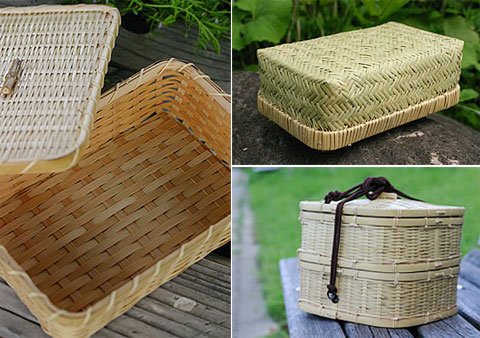Bento boxes of the week: Bamboo

This week I'm going back to the handcrafted bento boxes that I love. The material in the spotlight is bamboo.
Woven bamboo containers have been around probaby for thousands of years. Bamboo is a rapidly growing grass which has been under the spotlight recently because it's a sustainable plant material. It's water-resistant, durable and the leaves are said to have qualities. Here's a page with a history of bamboo used for food containers.
How practical is bamboo as a bento box? You obviously can't put anything very liquid in it. But it's great for solid things like onigiri and sandwiches. If you pack warm onigiri into a plastic container, it may get soggy by lunchtime, but by putting them a bamboo box, or wrapping them in dried bamboo leaves, the rice can 'breathe' without totally drying out. Wetter items can be packed in smaller containers that fit inside the box. Large bamboo bento boxes are very popular for taking along to _ohanami_, a picnic-party to appreciate cherry blossom trees, because they look so nice and are very lightweight. Imagine opening up several bamboo boxes filled with onigiri at a picnic! I wish I had more time to do things like that.
The bamboo bento boxes pictured above are from Taketora, a Japanese company that makes all their products by hand. The boxes range in price from 2,000 yen for this simple box made of white bamboo (shirotake) to a limited edition box made of bamboo leaves, which was designed by German architect Bruno Taut, for 12,000 yen. The ones pictured above are, from the left going clockwise 2,000 yen, 3,500 yen (this one is made of suzutake, a bamboo that retains a green color), and 3,800 yen.
What to look out for when shopping for bamboo food containers
- Make sure that the item feels strong enough - cheap baskets and such are thin and flimsy.
- A well made bamboo item should not have any splinters
- Bamboo does not need to be lacquered to be water resistant, so beware of thickly lacquered items which may be masking cheap material underneath
- Bamboo used for food containers is usually a a creamy white, a very light brown, or a light green in color, depending on the variety.
How to take care of bamboo food containers
Bamboo is quite water resistant. I use a couple of shallow bamboo baskets for cold soba (see one in action here); they are at least 15 years old and look as good as new. If it gets stained, wash it with dishwashing detergent and a non-scratching sponge, but otherwise you can just rinse it off in water. If rice grains get stuck, soak the container briefly in water and scrape off.
In Japan, where it's quite humid, baskets used for food are periodically put out in the sun to dry off completely. Since the climate is quite drier here in Switzerland, I do this maybe once or twice a year.
(If you are interested in buying any of these featured Japanese bento boxes or accessories and you don't have a relative or friend in Japan to help you out, try the overseas shipping services listed on this page. Note this is not an endorsement of any one of these services, but they do get positive reviews from Just Bento/Just Hungry readers.)
If you enjoyed this article, please consider supporting this site by becoming my patron via Patreon.
